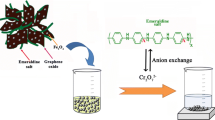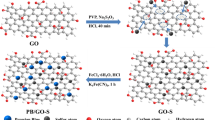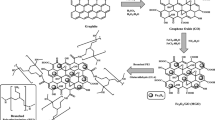Abstract
Magnetic Prussian blue graphene oxide (MPBGO) and Prussian blue graphene oxide nanocomposites prepared by a new synthetic approach were characterised by X-ray diffraction, Fourier transform infrared spectroscopy, Raman spectrometry, Mössbauer spectroscopy, and transmission electron microscopy. The adsorption data on the dependence of Cs(I) adsorption capacity on concentrations (obtained in batch experiments) fitted-well the Langmuir model with a maximum adsorption capacity of 943 mg·g–1 for the MPBGO composite. Adsorption kinetics studies showed better agreement of the experimental data of Cs(I) with the pseudo-second-order kinetics model. The MPBGO composite was used for the pre-concentration of 137Cs from seawater samples. The ANFIS model was used to predict the adsorption capacity of the synthesised composites.











Similar content being viewed by others
References
IAEA (2020) Energy, electricity and nuclear power estimates for the Period up to 2050, Reference Data Series No. 1, IAEA, Vienna
Steinhauser G, Brandl A, Johnson TE (2014) Comparison of the Chernobyl and Fukushima nuclear accidents: a review of the environmental impacts. Sci Total Environ 470:800–817
Loos-Neskovic C, Ayrault S, Badillo V et al (2004) Structure of copper-potassium hexacyanoferrate (II) and sorption mechanisms of cesium. J Solid State Chem 177:1817–1828
Ca DV, Cox JA (2004) Solid phase extraction of Cesium from aqueous solution using sol-gel encapsulated cobalt Hexacyanoferrate. Microchim Acta 147:31–37
Avramenko V, Bratskaya S, Zheleznov V et al (2011) Colloid stable sorbents for cesium removal: preparation and application of latex particles functionalized with transition metals ferrocyanides. J Hazard Mater 186:1343–1350
Ishizaki M, Akiba S, Ohtani A et al (2013) Proton-exchange mechanism of specific Cs+ adsorption via lattice defect sites of Prussian blue filled with coordination and crystallization water molecules. Dalt Trans 42:16049–16055
Takahashi A, Tanaka H, Minami K et al (2018) Unveiling Cs-adsorption mechanism of Prussian blue analogs: Cs+-percolation via vacancies to complete dehydrated state. RSC Adv 8:34808–34816
Yang HM, Jang SC, Hong SB et al (2016) Prussian blue-functionalized magnetic nanoclusters for the removal of radioactive cesium from water. J Alloys Compd 657:387–393
Chang L, Chang S, Chen W et al (2016) Facile one-pot synthesis of magnetic Prussian blue core/shell nanoparticles for radioactive cesium removal. RSC Adv 6:96223–96228
Jang J, Lee DS (2016) Magnetic prussian blue nanocomposites for effective Cesium removal from aqueous solution. Ind Eng Chem Res 55:3852–3860
Joshi NC, Gururani P (2022) Advances of graphene oxide based nanocomposite materials in the treatment of wastewater containing heavy metal ions and dyes. Curr Res Green Sustain Chem 5:100306
Paramasivam G, Palem VV, Sundaram T et al (2021) Nanomaterials: synthesis and applications in theranostics. Nanomater 11:3228
Asghar F, Shakoor B, Fatima S et al (2022) Fabrication and prospective applications of graphene oxide-modified nanocomposites for wastewater remediation. RSC Adv 12:11750–11768
Kong B, Selomulya C, Zheng G, Zhao D (2015) New faces of porous Prussian blue: interfacial assembly of integrated hetero-structures for sensing applications. Chem Soc Rev 44:7997–8018
Liu XW, Yao ZJ, Wang YF, Wei XW (2010) Graphene oxide sheet–prussian blue nanocomposites: green synthesis and their extraordinary electrochemical properties. Colloids Surfaces B Biointerfaces 81:508–512
Jang SC, Haldorai Y, Lee GW et al (2015) Porous three-dimensional graphene foam/Prussian blue composite for efficient removal of radioactive 137Cs. Sci Reports 5:1–10
Yang H, Sun L, Zhai J et al (2013) In situ controllable synthesis of magnetic Prussian blue/graphene oxide nanocomposites for removal of radioactive cesium in water. J Mater Chem A 2:326–332
Lujanienė G, Šemčuk S, Lečinskytė A et al (2017) Magnetic graphene oxide based nano-composites for removal of radionuclides and metals from contaminated solutions. J Environ Radioact 166:166–174
Seema H (2020) Novel self assembled magnetic Prussian blue graphene based aerogel for highly selective removal of radioactive cesium in water. Arab J Chem 13:4417–4424
Yang H, Li H, Zhai J et al (2014) Magnetic Prussian blue/graphene oxide nanocomposites caged in calcium alginate microbeads for elimination of Cesium ions from water and soil. Chem Eng J 246:10–19
Chen S, Dong Y, Wang H et al (2022) Highly efficient and selective cesium recovery from natural brine resources using mesoporous Prussian blue analogs synthesized by ionic liquid-assisted strategy. Resour Conserv Recycl 186:106542
Kim S, Jo S, Huh TH et al (2022) Cesium ion adsorption and desorption on electrospun mesoporous silica nanofibers immobilized with Prussian blue. Chemosphere 290:133318
Seo Y, Hwang Y (2021) Prussian blue immobilized on covalent organic polymer-grafted granular activated carbon for cesium adsorption from water. J Environ Chem Eng 9:105950
Hwang I-T, Han D-S, Sohn J-Y et al (2022) Preparation and cesium adsorption behavior of Prussian blue-based polypropylene nonwoven fabric by surfactant-assisted aqueous preirradiation graft polymerization. Radiat Phys Chem 199:110356
Dehbashi Nia N, Lee SW, Bae S et al (2022) Surface modification of polypropylene non-woven filter by O2 plasma/acrylic acid enhancing Prussian blue immobilization for aqueous cesium adsorption. Appl Surf Sci 590:153101
Foroutan R, Peighambardoust SJ, Mohammadi R et al (2020) Influence of chitosan and magnetic iron nanoparticles on chromium adsorption behavior of natural clay: adaptive neuro-fuzzy inference modeling. Int J Biol Macromol 151:355–365
Sadeghizadeh A, Ebrahimi F, Heydari M et al (2019) Adsorptive removal of Pb (II) by means of hydroxyapatite/chitosan nanocomposite hybrid nanoadsorbent: ANFIS modeling and experimental study. J Environ Manage 232:342–353
Dolatabadi M, Mehrabpour M, Esfandyari M et al (2018) Modeling of simultaneous adsorption of dye and metal ion by sawdust from aqueous solution using of ANN and ANFIS. Chemom Intell Lab Syst 181:72–78
Jang JSR (1992) Self-Learning Fuzzy Controllers Based on Temporal Back Propagation. IEEE Trans Neural Networks 3:714–723
Souza PR, Dotto GL, Salau NPG (2018) Artificial neural network (ANN) and adaptive neuro-fuzzy interference system (ANFIS) modelling for nickel adsorption onto agro-wastes and commercial activated carbon. J Environ Chem Eng 6:7152–7160
Onu CE, Nwabanne JT, Ohale PE, Asadu CO (2021) Comparative analysis of RSM, ANN and ANFIS and the mechanistic modeling in eriochrome black-T dye adsorption using modified clay. South African J Chem Eng 36:24–42
Noorani Khomeyrani SF, Azqhandi Azqhandi MH, Ghalami-Choobar B (2021) Rapid and efficient ultrasonic assisted adsorption of PNP onto LDH-GO-CNTs: ANFIS, GRNN and RSM modeling, optimization, isotherm, kinetic, and thermodynamic study. J Mol Liq 333:115917
Amiri MJ, Abedi-Koupai J, Eslamian SS et al (2013) Modeling Pb (II) adsorption from aqueous solution by ostrich bone ash using adaptive neural-based fuzzy inference system. J Environ Sci Health 48:543–558
Rezaei H, Rahmati M, Modarress H (2015) Application of ANFIS and MLR models for prediction of methane adsorption on X and Y faujasite zeolites: effect of cations substitution. Neural Comput Appl 28:301–312
Mendoza-Castillo DI, Reynel-Ávila HE, Sánchez-Ruiz FJ et al (2018) Insights and pitfalls of artificial neural network modeling of competitive multi-metallic adsorption data. J Mol Liq 251:15–27
Hummers WS, Offeman RE (1958) Preparation of graphitic oxide. J Am Chem Soc 80:1339
Marcano DC, Kosynkin DV, Berlin JM et al (2010) Improved synthesis of graphene oxide. ACS Nano 4:4806–4814
Zhang N, Chen S, Hu J et al (2020) Robust and recyclable sodium carboxymethyl cellulose–ammonium phosphomolybdate composites for cesium removal from wastewater. RSC Adv 10:6139–6145
Lujanienė G, Šemčuk S, Kulakauskaitė I et al (2015) Sorption of radionuclides and metals to graphene oxide and magnetic graphene oxide. J Radioanal Nucl Chem 307:2267–2275
Lujanienė G, Šilobritienė B, Tracevičienė D et al (2022) Distribution of 241Am and Pu isotopes in the Curonian Lagoon and the south-eastern Baltic Sea seawater, suspended particles, sediments and biota. J Environ Radioact 249:106892
ISO 10703:2007–Water quality–Determination of the activity concentration of radionuclides – Method by high resolution gamma-ray spectrometry. https://www.iso.org/standard/42756.html. Accessed 21 Sep 2022
Sada SO, Ikpeseni SC (2021) Evaluation of ANN and ANFIS modeling ability in the prediction of AISI 1050 steel machining performance. Heliyon 7:e06136
Ullah R, Khan SA, Aladresi AAM et al (2020) Ovalbumin-mediated synthesis and simultaneous functionalization of graphene with increased protein stability. Green Chem Lett Rev 13:60–67
Khalil MI (2015) Co-precipitation in aqueous solution synthesis of magnetite nanoparticles using iron(III) salts as precursors. Arab J Chem 8:279–284
Azhar A, Yamauchi Y, Allah AE et al (2019) Nanoporous Iron oxide/carbon composites through In-Situ deposition of Prussian blue nanoparticles on graphene oxide nanosheets and subsequent thermal treatment for supercapacitor applications. Nanomater 9:776
Moretti G, Gervais C (2018) Raman spectroscopy of the photosensitive pigment Prussian blue. J Raman Spectrosc 49:1198–1204
López-Díaz D, López Holgado M, García-Fierro JL, Velázquez MM (2017) Evolution of the raman spectrum with the chemical composition of graphene oxide. J Phys Chem C 121:20489–20497
Feng S, Cao X, Zheng W et al (2022) In-situ formed Prussian blue nanoparticles supported by porous biochar as highly efficient removal of cesium ions. J Environ Chem Eng 10:107972
Zhang Y, Wang H, Gao K et al (2022) Efficient removal of Cs(I) from water using a novel Prussian blue and graphene oxide modified PVDF membrane: Preparation, characterization, and mechanism. Sci Total Environ 838:156530
Rethinasabapathy M, Kang SM, Lee I et al (2019) Highly stable Prussian blue nanoparticles containing graphene oxide–chitosan matrix for selective radioactive cesium removal. Mater Lett 241:194–197
Ching K, Lian B, Leslie G et al (2020) Metal-cation-modified graphene oxide membranes for water permeation. Carbon N Y 170:646–657
Mohseni-Bandpei A, Eslami A, Kazemian H et al (2020) A high density 3-aminopropyltriethoxysilane grafted pumice-derived silica aerogel as an efficient adsorbent for ibuprofen: characterization and optimization of the adsorption data using response surface methodology. Environ Technol Innov 18:100642
Author information
Authors and Affiliations
Corresponding author
Ethics declarations
Conflict of interest
The authors declare that they have no conflict of interest.
Additional information
Publisher's Note
Springer Nature remains neutral with regard to jurisdictional claims in published maps and institutional affiliations.
Supplementary Information
Below is the link to the electronic supplementary material.
Rights and permissions
Springer Nature or its licensor (e.g. a society or other partner) holds exclusive rights to this article under a publishing agreement with the author(s) or other rightsholder(s); author self-archiving of the accepted manuscript version of this article is solely governed by the terms of such publishing agreement and applicable law.
About this article
Cite this article
Lujanienė, G., Novikau, R., Leščinskytė, A. et al. Prussian blue composites for Cs adsorption – modification of the method and modelling of the adsorption processes. J Radioanal Nucl Chem 332, 1033–1045 (2023). https://doi.org/10.1007/s10967-022-08660-z
Received:
Accepted:
Published:
Issue Date:
DOI: https://doi.org/10.1007/s10967-022-08660-z




